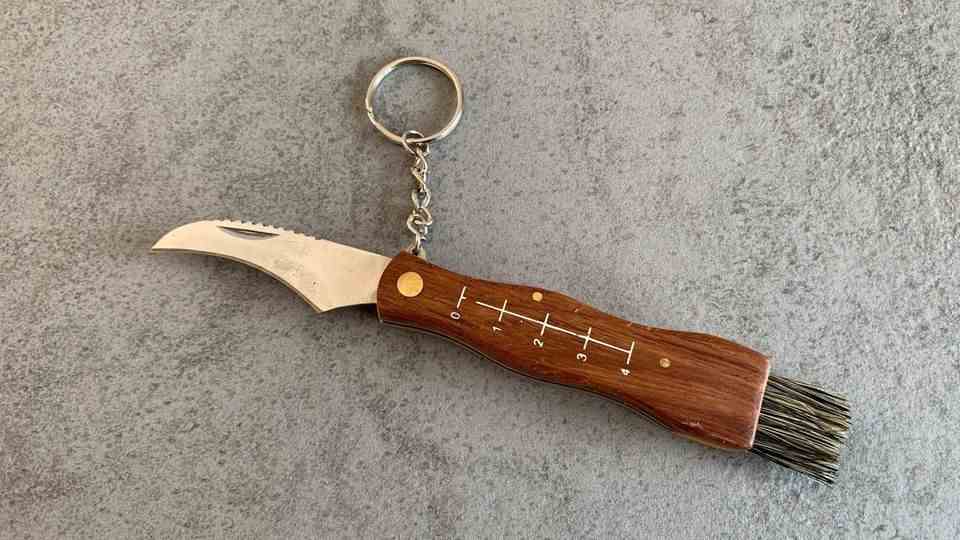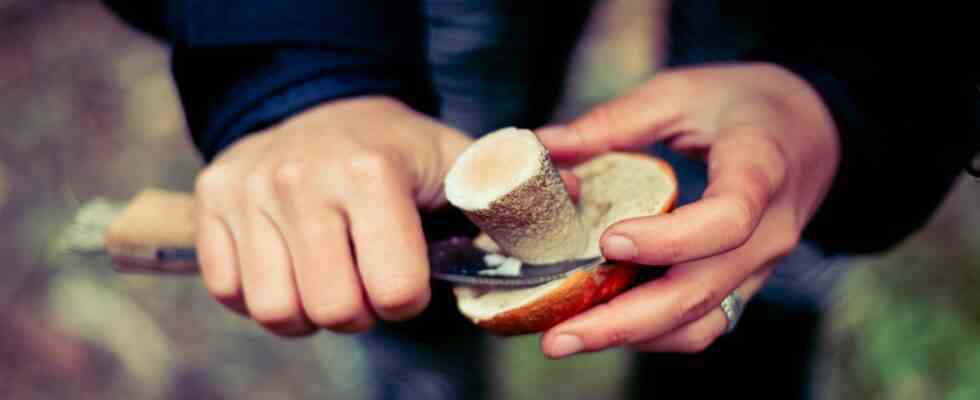cutting technique
Chestnuts, porcini & Co.: That’s why you should use a mushroom knife
Chestnuts & co. can be harvested with a mushroom knife without destroying the ecosystem
© MrandMrsTravel / Getty Images
After a long dry period, it’s finally raining again in Germany. It was only a matter of time before the first boletus sprouted from the forest floor – just in time for the beginning of autumn. So that they continue to do so next year, you should observe a few important rules of conduct when picking mushrooms.
It is easy for experienced collectors to distinguish poisonous mushrooms from edible ones. Beginners, on the other hand, can hardly tell many varieties apart, so they are recommended to only harvest boletes: they have no lamellae on the underside, but a kind of spongy structure – an important indication of non-toxic edible mushrooms. Nevertheless, caution is advised, because boletus also have toxic doubles. No matter how knowledgeable you are about mycology, don’t pull a single specimen out of the ground. Because the root networks are essential for a healthy ecosystem. “As microscopically thin cell threads, they run through the soil, wood and other substrates. In doing so, they convert organic matter into inorganic nutrients that are available to plants,” explains the German Society for Mycology. For this reason, you should only harvest the fruiting bodies on the surface. Best with a mushroom knife.
That’s why a mushroom knife is a better choice
In contrast to an ordinary pocket knife, which could undoubtedly also be used for harvesting, a mushroom knife has two decisive advantages: On the one hand, it has a curved blade, with which the fruit body can be cut off precisely and close to the ground. On the other hand, there are fine bristles at the lower end, with which coarse dirt can be removed from the mushrooms on site. In the following we will show you how the common models (minimal) differ from each other.
1. Oramics Mushroom Knife
This 65 gram light mushroom knife made of wood has a six centimeter long blade made of stainless steel that is slightly curved. There is a serrated saw pattern on the back of the blade to remove coarse soil residue from the fruiting bodies. In addition, the knife has a fine mushroom brush at the lower end. An additional storage bag is included in the delivery.
2. Mushroom knife from Opinel
The French brand Opinel has also launched its own mushroom knife. It has a special Virobloc security ring that locks the eight-centimetre-long, curved blade (with a slightly serrated back) when it is closed – and blocks it when it is open. There is also a brush made of natural bristles at the end of this knife.
3. Jobukam mushroom knife
Also this one mushroom knife has the same characteristics as its predecessors. However, the look is a bit more noble, which is due to the fine wood grain of the handle and the higher proportion of stainless steel. The 5.3 centimeter blade made of stainless steel is equipped without a sawmill on the back. According to the manufacturer, the knife is delivered in a beautiful box.
4. Mercury Mushroom Knife
This olive wood handle has a centimeter printed on it to help you quickly determine the size of mushrooms. The seven centimeter long blade is also on this one pocket knife slightly curved, there is also a small brush on the handle. In addition, small tweezers are hidden at the end of the handle, which can be used when collecting.
Harvesting mushrooms: It is important to note this
According to the German Society for Mycology, there are a few important basic rules to follow when picking mushrooms – not only to protect nature, but also for the sake of your own health. They are as follows:
- Never pull mushrooms out of the ground, otherwise no new ones can grow in the same place.
- Always avoid young, maggot, old – and of course poisonous – mushrooms.
- Do not eat mushrooms in their raw state, otherwise they can lead to gastrointestinal problems.
- Only collect as many mushrooms as you can actually eat, as most types spoil quickly.
- Transport mushrooms in an air-permeable container such as a basket, otherwise they will be crushed.
Mushroom knife in the test: This is how the tool cuts off This mushroom knife was subjected to a practical test in the forest. © star
To find out how well a mushroom knife works in practice, we have this handy model tested by Oramics. On our search for edible boletus, we found what we were looking for in the Sachsenwald – even if we were only able to discover a few chestnuts. To harvest the mushrooms, we unfolded the knife and cut off the stems low to the ground with the curved blade. It actually worked flawlessly. And the brush at the end of the handle also proved to be very useful for carefully removing coarse dirt from the handles. The handling was therefore very easy and the use was a complete success. Nevertheless, it can be assumed that an ordinary pocket knife (apart from the curved blade and missing brush) would probably serve the same purpose. By far the most important point is and remains that the boletus should not be torn out of the ground, but carefully cut off. Whether with a mushroom knife or another sharp object.
Source: German Society for Mycology
You might also be interested in:
This article contains so-called affiliate links. There is more information here.


